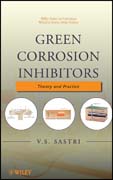
A book to cover developments in corrosion inhibitors is long overdue. This has been addressed by Dr Sastri in a book which presents fundamental aspects of corrosion inhibition, historical developments and the industrial applications of inhibitors. The book deals with the electrochemical principles and chemicalaspects of corrosion inhibition, such as stability of metal complexes, the Hammett equation, hard and soft acid and base principle, quantum chemical aspects and Hansch' s model and also with the various surface analysis techniques, e.g. XPS, Auger, SIMS and Raman spectroscopy, that are used in industry for corrosion inhibition. The applications of corrosion inhibition are wide ranging. Examples given in this book include: oil and gas wells, petrochemical plants, steel reinforced cement, water cooling systems, and many more. The final chapters discuss economic and environmental considerations which are now of prime importance. The book is written for researchers in academia and industry, practicing corrosion engineers and students of materials science, engineering and applied chemistry. INDICE: Preface. 1 Introduction and Forms of Corrosion. 1.1 Definition. 1.2 Developments in Corrosion Science. 1.3 Development of Some Corrosion-RelatedPhenomena. 1.4 Economics of Corrosion. 1.5 Safety and Environmental Considerations. 1.6 Forms of Corrosion. 1.6.1 General Corrosion. 1.6.2 Galvanic Corrosion. 1.6.3 Crevice Corrosion. 1.6.4 Pitting Corrosion. 1.6.5 Dealloying or Selective Leaching. 1.6.6 Intergranular Corrosion. 1.6.7 Cavitation Damage. 1.6.8 Fretting Corrosion. 1.6.9 Corrosion Fatigue. 1.6.10 Stress-Corrosion Cracking.1.7 Corrosion Inhibition. References. 2 Electrochemical Principles and Corrosion Monitoring. 2.1 Thermodynamic Basis. 2.2 Nature of Corrosion Reactions. 2.3 Standard Electrode Potentials. 2.4 Pourbaix Diagrams. 2.5 Dynamic Electrochemical Processes. 2.6 Monitoring Corrosion and Effectiveness of Corrosion Inhibitors. 2.6.1 Objectives of Corrosion Monitoring. 2.6.2 Corrosion Monitoring Probe Location. 2.6.3 Probe Type and its Selection. 2.6.4 Direct Intrusive Corrosion Monitoring Techniques. 2.6.4.1 Physical Techniques. 2.6.4.2 Electrical Resistance. 2.6.4.3 Inductive Resistance Probes (22). 2.6.4.4 Electrochemical Techniques. 2.6.4.5 Linear Polarization Resistance. 2.6.4.6 Zero-Resistance Ammetry. 2.6.4.7 PotentiodynamicGalvanodynamic Polarization. 2.6.4.8 Electrochemical Noise. 2.6.4.9 Electrochemical Impedance Spectroscopy. 2.6.4.10 Harmonic Distortion Analysis. 2.6.5 Direct Nonintrusive Techniques. 2.6.5.1 Ultrasonics. 2.6.5.2 Magnetic Flux Leakage. 2.6.5.3 Eddy Current Technique. 2.6.5.4 Remote Field Eddy Current Technique. 2.6.5.5 Radiography. 2.6.5.6 Thin-Layer Activation and Gamma Radiography. 2.6.5.7 Electrical Field Mapping. 2.6.6 Indirect On-Line Measurement Techniques. 2.6.6.1 Hydrogen Monitoring. 2.6.6.2 Corrosion Potential. 2.6.6.3 On-Line Water Chemistry Parameters. 2.6.6.3.1 pH. 2.6.6.3.2 Conductivity. 2.6.6.3.3 Dissolved Oxygen. 2.6.6.3.4 OxidationReduction Potential. 2.6.7 Fluid Detection. 2.6.7.1 Flow Regime. 2.6.7.2 Flow Velocity. 2.6.7.3 Process Parameters. 2.6.7.4 Pressure. 2.6.7.5 Temperature. 2.6.7.6 Dew Point. 2.6.7.7 Fouling. 2.6.8 Indirect Off-Line Measurement Techniques. 2.6.8.1 Off-Line Water Chemistry Parameters. 2.6.8.1.1 Alkalinity. 2.6.8.1.2 Metal Ion Analysis. 2.6.8.1.3 Concentration of Dissolved Solids. 2.6.8.1.4 Gas Analysis. 2.6.8.1.5 Residual Oxidant. 2.6.8.1.6 Microbiological Analysis. 2.6.8.1.7 Residual Inhibitor. 2.6.8.1.8 Filming Corrosion Inhibitor Residual. 2.6.8.1.9 Reactant Corrosion Inhibitor Residual. 2.6.8.1.10 Chemical Analysis of Process Samples. 2.6.8.1.11 Sulfur Content. 2.6.8.1.12 Total Acid Number. 2.6.8.1.13 Nitrogen Content. 2.6.8.1.14 Salt Content of Crude Oil. References. 3 Adsorption in Corrosion Inhibition. 3.1 Adsorption of Inhibitor at the Metal Surface. 3.2 Corrosion Inhibitors. 3.3 Adsorption Isotherms. 3.4 Anodic Dissolution and Adsorption. 3.4.1 Formation of Passive Films. 3.5 Role of Oxyanions (Passivation) inCorrosion Inhibition. 3.6 Inhibition of Loca
- ISBN: 978-0-470-45210-3
- Editorial: John Wiley & Sons
- Encuadernacion: Cartoné
- Páginas: 328
- Fecha Publicación: 24/06/2011
- Nº Volúmenes: 1
- Idioma: Inglés
